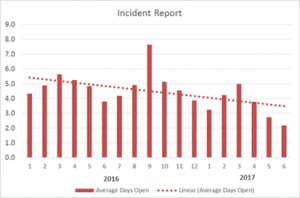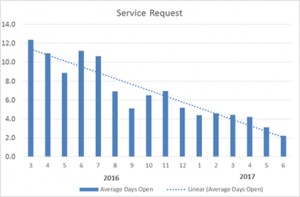 Providing Accountable Service
Providing Accountable Service
Nebraska’s first phase of consolidation regarding networks was implemented in just under 12 months. Then, in June 2016, 11 employees from three agencies came on board to be part of the enterprise network team. This team now provides support for all of the agencies. In September of 2016, 24 IT employees from ten cabinet agencies consolidated into the enterprise infrastructure environment. They support our server environment. The third phase of consolidation we called “Site Support.” This is when we established regional-based support versus Agency-specific support. Hence my CIO Blog back in March 2017.
When you take over IT support, the first thing you are asked is, What service level can I expect?
My response is always the same: What is your service level now?
Whether public or private industry, the answer is often similar. “It’s good,” or, “We simply don’t have time to gather that information.”
Regardless of if the business is private or public sector, the organization needs to be able to monitor performance progress against service goals. If you are not tracking “Fundamental Data,” then you are relying on intuition, perception or simply what you want to believe. In the monthly CIO Blog, I discussed how IT Service Management (ITSM) tools helped us evaluate the effectiveness and efficiency of our work. At some point in time, managers must collect accurate data about customer support from their teams and learn how to manage these metrics. Certainly, this is key to improving a level of service.
Exceeding Customer Expectations
Response time and first-call resolution are often the deciding factors between a good and bad customer support experience. The State of Nebraska has an Enterprise ITSM tool to assist the agencies in tracking and measuring this valuable information. Some of the information can only be gathered by using an ITSM tool, specifically:
- the customer’s preferred contact channel
- the total number of incidents and service requests assigned during a time period
- the requests sorted by category
- the number and types of requests that are assigned to a particular resolving group or agency
- the average time to “resolution”
Best of all, managers can use ITSM to easily look back at data and gain awareness of how their customers want to interact (portal, phone call, etc.) and how they were handled by the support team.
Not having the structure in place to track these data points is a roadblock to any organization’s improvement and results in lost opportunities due to misconceptions. Here are the top three reasons to buy into ITSM:
Gain Back Lost Opportunities
An ITSM tool helps business managers identify the gaps in service, analyze data trends and eliminate the root cause of issues. Actionable data improves the overall support of your customers’ needs. Beyond that, any issues that might otherwise go unnoticed get highlighted before they become “unresolved.”
A Service or Help Desk typically handles hundreds of tickets per day. There are frequently a significant number of recurring tickets, meaning that efficiency and productivity are both lost in solving the same issue repeatedly.
Set Customer Expectations by your Proven Standards
Structured data in the form of metrics help frame your service level expectations both internally and with your customers. An ITSM tool can provide real-time service level updates, allowing you to plan confidently within a timeline. We already know that good customer support revolves around quick, accurate communication. Setting accurate expectations, up front, empowers both sides of the business to prepare for the unexpected.
Data changes perception into reality
From determining what actually happened with a particular incident/service request to managing a level of service for an agency, fundamental data gives managers the ability to analyze service levels objectively.
Telling a Story
There are numerous reasons and purposes for using a tool to gather information on incidents and service requests. In Nebraska, we communicate what is important by measuring trackable data and then by analyzing the story told by the metrics.
For example, I track the average number of days “open” for incidents and service requests to gauge our progress against our service level objectives (steady improvement as you can see from the trend line). Another important metric I make sure to review is from the ITSM Change Management module. Below is the report that shows us hitting the objective of 98% successfully trending upward every month. This is not a measure of impact. The implementing teams back out a change if issues occur and implement changes after hours to further minimize the impact of changes to customers.


How does your organization utilize data to obtain metrics? I would love to hear about your victories with using an ITSM tool.
Ed Toner is part of the GovLoop Featured Contributor program, where we feature articles by government voices from all across the country (and world!). See more Featured Contributor posts.





Leave a Reply
You must be logged in to post a comment.